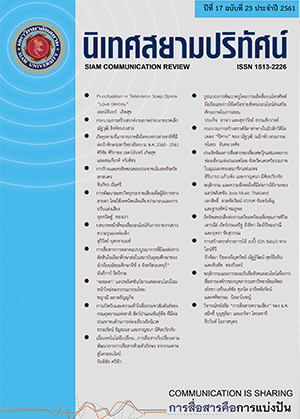The Influence of Media on Preparation for Quality of Life
Main Article Content
Abstract
In this thesis, the researcher studies exposure to media and working people who are making preparations for enhancing their quality of life. The researcher also examines the influence of media on these working people and on their preparations for enhancing their quality of life. The independent variables in this quantitative research investigation were exposure to traditional media, exposure to new media, health preparations (physical and mental), economic preparations, and social preparations. The dependent variables were the quality of life and expectations for the quality of life. Using techniques of descriptive statistics, the researcher analyzed the data collected in terms of percentage, mean, and standard deviation. In the testing of hypothesis, the researcher employed Pearson’s product moment correlation coefficient (PPMCC) method in addition to multiple regression analysis (MRA). Findings are as follows: Exposures to traditional media, new media, and preparations for the quality of life in respect to the itemized aspects of health, economics and society were evinced at a moderate level (M = 3.19). When considering each itemized aspect, it was found that new media exposure—viz., exposure to Line, Facebook and websites—was exhibited at a high level (M = 3.50). Preparations for the quality of life in the three aspects considered were found to hold at a moderate level for health (M = 3.34), society (M = 3.24) and economics (M = 3.09), respectively. The results of hypothesis testing are as follows: Model A: Media exposure and preparations positively affected the quality of life. Hypothesis 1.1: New media exposure positively affected the quality of life. Hypothesis 1.2: Social preparations positively affected the quality of life. Hypothesis 1.3: Economic preparations positively affected the quality of life. Hypothesis 1.4: Health preparations (physical and mental) positive ly affected the quality of life. Hypothesis 1.5: Traditional media exposure did not positively affect the quality of life. Model B: Media exposure and preparations positively affected expectations for the quality of life. Hypothesis 2.1: New media exposure positively affected expectations for the quality of life. Hypothesis 2.2: Social preparations positively affected expectations for the quality of life. Hypothesis 2.3, hypothesis 2.4, and hypothesis 2.5—viz., traditional media exposure, health preparations (physical and mental), and economic preparations—did not positively affect expectations for the quality of life.
Article Details
References
กายกาญจน์ เสนแก้ว. (2558). พฤติกรรมการใช้เครือข่ายสังคมออนไลน์ของ Gen-X ใน กรุงเทพมหานคร. วิทยานิพนธ์ปริญญามหาบัณฑิต, มหาวิทยาลัยกรุงเทพ.
จรุง วรบุตร. (2550). พฤติกรรมการดูแลสุขภาพตนเองของประชาชนวัยกลางคน อําเภอศรีสวัสดิ์ จังหวัดกาญจนบุรี. วิทยานิพนธ์ปริญญามหาบัณฑิต, มหาวิทยาลัยศิลปากร.
บรรลุ ศิริพานิช. (2550). คู่มือผู้สูงอายุ: ฉบับเตรียมตัวก่อนสูงอายุ (เตรียมตัวก่อนเกษียณอายุการงาน). กรุงเทพฯ: หมอชาวบ้าน.
ประภาสวัชร์ งามคณะ. (2557). พฤติกรรมการดูแลสุขภาพของคนไทยในเขตปริมณฑล. วารสารวิชาการมหาวิทยาลัยปทุมธานี. 6(2), 21-30.
พภัช เชิดชูศิลป์. (2557). พฤติกรรมการใช้ไลน์ที่มีผลต่อความพึงพอใจและการใช้ประโยชน์ของนักศึกษามหาวิทยาลัยศรีปทุม. วิทยานิพนธ์ปริญญามหาบัณฑิต, มหาวิทยาลัยศรีปทุม.
พีระ จิรโสภณ. (2548). ทฤษฎีการสื่อสารมวลชน. ใน มหาวิทยาลัยสุโขทัยธรรมาธิราช. สาขาวิชานิเทศศาสตร์, ประมวลสาระชุดวิชาปรัชญานิเทศศาสตร์และทฤษฎีการสื่อสาร หน่วยที่ 10. (หน้า 148-151). นนทบุรี: มหาวิทยาลัยสุโขทัยธรรมาธิราช.
ศิรประภา วัฒนากิตติกูล. (2552). การเตรียมการเพื่อให้เป็นวัยสูงอายุที่มีสุขภาพดี (healthy aging) ของกำลังพลที่ปฏิบัติงานภายในกองทัพภาคที่ 1. วิทยานิพนธ์ปริญญามหาบัณฑิต, มหาวิทยาลัยธรรมศาสตร์.
ศุภศิลป์ กุลจิตต์เจือวงศ์. (2556). ไลน์รูปแบบการสื่อสารบนความสร้างสรรค์ของสมาร์ทโฟน: ข้อดีและข้อจำกัดของแอปพลิเคชัน. วารสารนักบริหาร. 33(4), 42-54.
สุคี ศิริวงศ์พากร. (2556). การศึกษาพฤติกรรมการเปิดรับข่าวสารที่มีความสัมพันธ์กับความสามารถ ในการพึ่งพาตนเองของผู้สูงอายุในกรุงเทพมหานคร (รายงานวิจัย). กรุงเทพมหานคร: มหาวิทยาลัยเทคโนโลยีราชมงคลพระนคร.
สุทธิพงศ์ บุญผดุง. (2554). การพัฒนาคุณภาพชีวิตผู้สูงอายุในท้องถิ่นโดยใช้โรงเรียนเป็นฐานตามหลักเศรษฐกิจพอเพียง (ระยะที่ 1) (รายงานวิจัย). กรุงเทพมหานคร: มหาวิทยาลัยราชภัฏสวนสุนันทา.
อดิสรณ์ อันสงคราม. (2556). ผลกระทบจากการใช้สื่อโซเชียลมีเดียของคนวัยทำงานในกรุงเทพมหานครและปริมณฑล (รายงานวิจัย). กรุงเทพมหานคร: มหาวิทยาลัยศรีปทุม.
กรมการปกครอง. (2560). ข้อมูลประชากร. เข้าถึงได้จาก http://stat.bora.dopa.go.th/stat/marry/sk/sk_59.html


